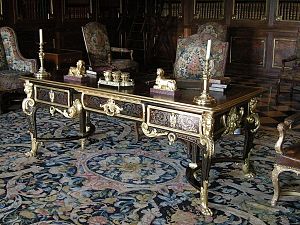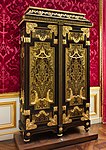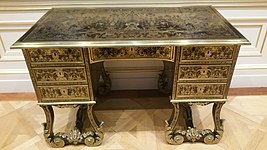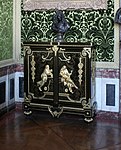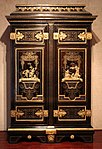André-Charles Boulle

André-Charles Boulle (born November 11, 1642 in Paris ; † February 29, 1732 there ) was a French cabinet maker . André-Charles Boulle was the child of Dutch emigrants . The father Jean Bolt (Frenchified: Jean Boule) moved in 1610 from the German part of the Duchy of money to Paris and worked for the widow of the German cabinetmaker Jean Senapre .
Appreciation
André-Charles Boulle is considered one of the most outstanding craftsmen and artists in the field of marquetry in France in the 17th century. He is an important representative of the Louis-quatorze and Régence styles . Boulle worked mainly for the French court until the royal manufactory was temporarily closed in 1694. His work influenced cabinet making across Europe. The Boullemarketerie , which was further developed by André-Charles Boulle and named after him, differs from conventional marquetry in terms of the materials used.
The renowned furniture-making school École Boulle on Rue du Faubourg Saint-Antoine in Paris is named after him .
background
Between 1662 and 1667 the program begun under Henri de Navarre for the renewal and centralization of the crafts and the arts was continued by the later finance minister contrôleur général des finances Jean-Baptiste Colbert . This led to the establishment of the Manufacture royale des Meubles de la Couronne (Royal Manufacture of Crown Furniture) after 1662 . In the royal manufactories attached to it such as u. a. the Manufacture Royale des Gobelins , the Manufacture de la Savonnerie , the Manufacture Royale des Glaces de Miroirs (Royal Mirror Manufactory) and the Manufacture royale des Meubles necessary for representative decoration were trades summarized. By working with the same time founded by Colbert Academies this created iconographic and materially the baroque representation style Louis XIV.
In the first decades, the focus was on decorating the apartments in the Louvre and the Palace of Versailles . The tasks of the manufactory consisted in the establishment and maintenance of the royal inventory of the royal castles and palaces administered by the Bâtiments du Roi . From 1664, the management of the bâtiments was the responsibility of the surintendant et ordonnateur général des bâtiments, arts, tapisseries et manufactures de France, parallèlement contrôleur général des finances et secrétaire d'État à la Maison du Roi , Jean-Baptiste Colbert. He chose the king's first painter, Charles Le Brun , who was also the director of the Académie royale de peinture et de sculpture (Academy for Painting and Sculpture) in Paris and founder of the Académie de France à Rome, as his artistic director . The concentration of financial and artistic influence contributed significantly to the development of the homogeneous decoration. This became exemplary for the development of the European baroque interior. Within the courtly ceremonial , the furniture played an important role as a decorative, representative and functional element.
The massive silver furniture made in the workshops for the large apartment and the mirror gallery in Versailles remained unprecedented in the history of European furniture construction in terms of craftsmanship and artistic quality, as well as the value of the material used and the spatial arrangement. Designed for the Hall of Mirrors as Trinity Console as a basis for the overlying in silver framed mirror and both sides flanking silver Gueridons were a milestone in the lighting concept of interiors. However, the entire silver furniture was melted down during the Palatinate War of Succession due to a lack of money. From the last decade of the 17th century, this was followed by furniture using the Boulle technique, some of which were decorated with grotesque motifs by Jean Bérain .
In addition to André Charles Boulle, there were other machinists who carried out work using the Boulle technique . Alexandre-Jean Oppenordt and Bernard I Van Risamburgh are among the most prominent contemporaries .
plant

Little is known about André-Charles Boulle's childhood and education. The training in his father's workshop has been handed down. It is believed that Boulle trained as a painter, as one of the first invoices ouvrages de peinture was made for this activity.
From 1667 Boulle is registered in the Paris guild . He is said to have employed up to 40 people in his own workshop. On the recommendation of Jean-Baptiste Colbert, who described him as “ le plus habile ébéniste de Paris ” , André-Charles Boulle took over the royal furniture workshop in the Louvre after the death of Jean Macé van Blois in 1672 as ébéniste du Roi . In the Louvre, he was given the privilege of making his own marquetry and bronze work as an engraver and chaser and as a gilder, independent of the guild laws. The Ebeniste du Roi title was associated with an annual salary and an apartment in the Louvre. Boulle kept this apartment until his death at the age of 89. Until the Royal Manufactory was temporarily closed in 1694 , Boulle was mainly entrusted with furnishing the royal castles. Some of his pieces were also given as gifts to ambassadors from Allied courts.
The technique of marquetry was established in France at the beginning of the 17th century, mainly by Italian, Dutch and German cabinet makers. With the establishment of the royal manufactories in Paris, the calling of excellent craftsmen was connected. In addition to his predecessor Jean Macé van Blois, works by Pierre Gole Pierre Golle , Auburtin Gaudron and Dominique Cucci , some of whom worked together, were formative for Boulle .
Ornamental floors
Like Pierre Gole, André-Charles Boulle was involved in the manufacture of decorative floors and boiserie in Versailles. Pierre Gole led a. a. the decorative floor in the Cabiné Doré in Versailles, while the execution of the floor in the neighboring Grand Cabinet Cabinet de Dauphin is ascribed to André-Charles Boulle. The traditional design of the Cabinet Doré is reminiscent of a knotted carpet from the Savonnerie. A contemporary of Boule with comparable stylistic features was the cabinet maker Alexandre-Jean Oppenordt . He made the floors in the Petite Galerie . For many of the inlaid floors, such as in the Hôtel de Soubise or in the mirror cabinet of Maisons-Laffitte Castle , attributions are not yet possible. In Boulle's work, however, it was probably the more elaborate inlaid floors .
Furniture
The most important works were made between 1680 and 1710. Between 1682 and 1686, André-Charles Boulle made the inlay floors and wall paneling for 94,000 livres, as well as the console tables and chairs for the Cabinet des Glaces in the Château de Versailles for the new apartment of Louis of France, Le Grand Dauphin .
During this time, his customers also included King Philip V of Spain, Elector Max Emanuel of Bavaria and the Archbishop of Cologne .
A number of his later pieces of furniture have fire-gilded bronzes made by Etienne Forestier .
technology
The term Boullemarketerie is used colloquially for the technology used and as a term of style. André-Charles Boulle perfected the marquetry technique. The use of improved tools made faster and more precise production possible.
gallery
- Boulle furniture
Boulle cabinet in the Metropolitan Museum of Art , New York.
Table in marquetry , c. 1670–80, California Palace of the Legion of Honor, San Francisco .
Pendulum clock, André-Charles Boulle and Sons, ca.1720, Detroit Institute of Arts
Secretary, Wallace Collection , London.
Cabinet with gilded marquetry from Boulle, Louvre , Paris
Medal cabinet in the Salon of Abundance, Palace of Versailles
Cassette, Art Institute of Chicago .
Boulleschrank, around 1700, Museu Calouste Gulbenkian , Lisbon
Work
- 1682–1683: Inlaid floor for the Cabinet Doré des Dauphins in Versailles, not preserved.
- 1719: Toilet mirror in Boulle Marketrie based on motifs by Jean Louis Berain the Elder (1637–1711), made for Marie Louise Élisabeth d'Orléans , widowed Duchess of Berry, now in the Wallace Collection
- around 1720: Barometer and thermometer made for the illegitimate son Louis XIV. Louis-Alexandre de Bourbon, comte de Toulouse
- around 1720: Bureau-Plat aux têtes de satyre made for a French family.
Boulle Revival
During the July monarchy of Ludwig Philipp and especially in the reign of Napoleon III. A number of high quality replicas of pieces attributed to André-Charles Boulle were created. This work was also called Buhl work . Since the attribution of many originals has not always been unequivocally clarified to this day, some of the copies were not originals by Boulle, but by his contemporaries. Examples of this are the copies of a desk made by John Webb between 1853 and 1857 for the 4th Marquess of Hertford . The original did not come from Boulle, as assumed, but from Bernard I. van Risamburgh, who made it for the Elector Max Emanuel of Bavaria.
Archives
- The Boulle Archives , Center de Recherches Historiques, 92 rue La Fayette, 75009 Paris, + 33 1 47 70 19 02, [email protected]
- Musée des Arts Décoratifs
Collections
- Bougthon
- Blenheim Pallace
- Louvre Gallery, Paris
- Waddeston Manor
- Wallace Collection
- Between October 2009 and January 2010, an international exhibition on André-Charles Boulle took place in the Museum Angewandte Kunst in Frankfurt am Main , where 100 of his works from 30 European museums were shown.
literature
- Essays
- Jean Nérée Ronfort: André-Charles Boulle. The bronze work and his workshop in the Louvre . In: Hans Ottomeyer u. a .: Gilded bronzes. The bronze work of the late baroque and classicism . Klinkhardt & Biermann, Munich 1986, ISBN 3-7814-0217-7 .
- 2. Contributions to the history and technique of bronze work, to artists and workshops .
- Jean Nérée Ronfort: André-Charles Boulle (1642-1732). Chronology nouvelle de sa vie et de son œuvre . In: Dossier de l'Art , No. 124, November 2005, Editions Faton, Dijon.
- Jean Nérée Ronfort: André-Charles Boulle. Commandes pour le Grand Dauphin at Versailles . In: Dossier de l'Art , No. 124, November 2005, Editions Faton, Dijon.
- Jean Nérée Ronfort: André-Charles Boulle. Commandes pour la duchesse de Bourgogne à Versailles et au château de la Ménagerie . In: Dossier de l'Art , No. 124, November 2005, Editions Faton, Dijon.
- Jean Nérée Ronfort: André-Charles Boulle. The bronze work and his workshop in the Louvre . In: Hans Ottomeyer u. a .: Gilded bronzes. The bronze work of the late baroque and classicism . Klinkhardt & Biermann, Munich 1986, ISBN 3-7814-0217-7 .
- Monographs
- Yannick Chastang: Paintings in wood. French marquetry furniture . Wallace Collection, London 2002, ISBN 0-900785-66-7 (catalog for the exhibition of the same name).
- Adolf Feulner: Art history of furniture (Propylaen art history; special volume 2). Propylaea publishing house, Frankfurt / M. 1980.
- Peter Hughes: The Wallace Collection: Catalog of Furniture . Wallace Collection, London 2000, ISBN 0-900785-51-9 .
- Hiltrud Kier : Ornamental floors in the Renaissance and Baroque (Art History Studies; Vol. 49). Deutscher Kunstverlag, Munich 1976, ISBN 3-422-00679-6 .
- Fiske Kimball : The creation of the Rococo decorative style . Dover Publications, New York 1980, ISBN 0-486-23989-6 .
- Jean Nérée Ronfort: Boulle et Versailles. Nouvelles découvertes . Editions Faton, Dijon. ISSN 1161-3122 , November 2005.
- Peter Thornton : Seventeenth-century interior decoration in England, France and Holland . Yale University Press, New Haven, Conn 1990, ISBN 0-300-02193-3 .
Web links
- Information on Boulletechnik
- André-Charles Boulle biography
- Boulle & Versailles
- Ecole Boulle Paris
- André Charles Boulle (1642–1732) and the art of his time, a new style for Europe
Individual evidence
| personal data | |
|---|---|
| SURNAME | Boulle, André-Charles |
| BRIEF DESCRIPTION | French cabinet maker |
| DATE OF BIRTH | November 11, 1642 |
| PLACE OF BIRTH | Paris |
| DATE OF DEATH | February 29, 1732 |
| Place of death | Paris |
